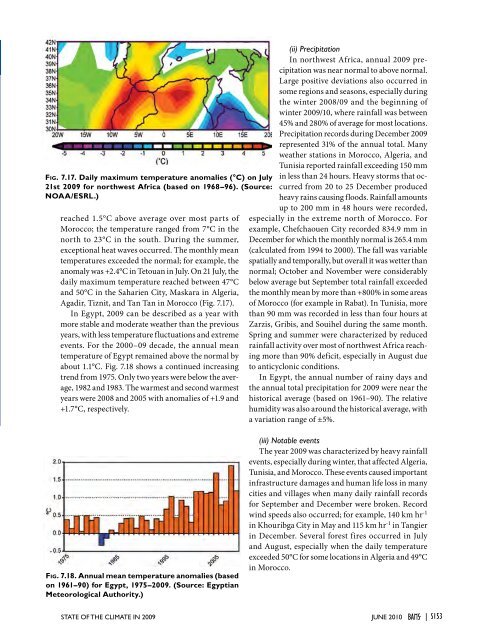Create successful ePaper yourself
Turn your PDF publications into a flip-book with our unique Google optimized e-Paper software.
Fig. 7.17. Daily maximum temperature anomalies (°C) on July21st <strong>2009</strong> for northwest Africa (based on 1968–96). (Source:NOAA/ESRL.)reached 1.5°C above average over most parts ofMorocco; the temperature ranged from 7°C in thenorth to 23°C in the south. During the summer,exceptional heat waves occurred. The monthly meantemperatures exceeded the normal; for example, theanomaly was +2.4°C in Tetouan in July. On 21 July, thedaily maximum temperature reached between 47°Cand 50°C in the Saharien City, Maskara in Algeria,Agadir, Tiznit, and Tan Tan in Morocco (Fig. 7.17).In Egypt, <strong>2009</strong> can be described as a year withmore stable and moderate weather than the previousyears, with less temperature fluctuations and extremeevents. For the 2000–09 decade, the annual meantemperature of Egypt remained above the normal byabout 1.1°C. Fig. 7.18 shows a continued increasingtrend from 1975. Only two years were below the average,1982 and 1983. The warmest and second warmestyears were 2008 and 2005 with anomalies of +1.9 and+1.7°C, respectively.(ii) PrecipitationIn northwest Africa, annual <strong>2009</strong> precipitationwas near normal to above normal.Large positive deviations also occurred insome regions and seasons, especially duringthe winter 2008/09 and the beginning ofwinter <strong>2009</strong>/10, where rainfall was between45% and 280% of average for most locations.Precipitation records during December <strong>2009</strong>represented 31% of the annual total. Manyweather stations in Morocco, Algeria, andTunisia reported rainfall exceeding 150 mmin less than 24 hours. Heavy storms that occurredfrom 20 to 25 December producedheavy rains causing floods. Rainfall amountsup to 200 mm in 48 hours were recorded,especially in the extreme north of Morocco. Forexample, Chefchaouen City recorded 834.9 mm inDecember for which the monthly normal is 265.4 mm(calculated from 1994 to 2000). The fall was variablespatially and temporally, but overall it was wetter thannormal; October and November were considerablybelow average but September total rainfall exceededthe monthly mean by more than +800% in some areasof Morocco (for example in Rabat). In Tunisia, morethan 90 mm was recorded in less than four hours atZarzis, Gribis, and Souihel during the same month.Spring and summer were characterized by reducedrainfall activity over most of northwest Africa reachingmore than 90% deficit, especially in August dueto anticyclonic conditions.In Egypt, the annual number of rainy days andthe annual total precipitation for <strong>2009</strong> were near thehistorical average (based on 1961–90). The relativehumidity was also around the historical average, witha variation range of ±5%.Fig. 7.18. Annual mean temperature anomalies (basedon 1961–90) for Egypt, 1975–<strong>2009</strong>. (Source: EgyptianMeteorological Authority.)(iii) Notable eventsThe year <strong>2009</strong> was characterized by heavy rainfallevents, especially during winter, that affected Algeria,Tunisia, and Morocco. These events caused importantinfrastructure damages and human life loss in manycities and villages when many daily rainfall recordsfor September and December were broken. Recordwind speeds also occurred; for example, 140 km hr -1in Khouribga City in May and 115 km hr -1 in Tangierin December. Several forest fires occurred in Julyand August, especially when the daily temperatureexceeded 50°C for some locations in Algeria and 49°Cin Morocco.<strong>STATE</strong> <strong>OF</strong> <strong>THE</strong> <strong>CLIMATE</strong> <strong>IN</strong> <strong>2009</strong> juNE 2010 |S153
















